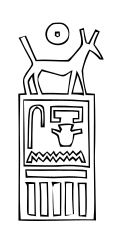Horus name
| Horus name (Serekh name) in hieroglyphs | |||
|---|---|---|---|
srḫ serekh facade (of the palace) |
|||
| Serekh of king Djet with the Horus falcon above | |||
| Serekh of king Peribsen with the Seth animal and a sun disc above | |||
The Horus name is the oldest known and used crest of Ancient Egyptian rulers. It belongs to the "Great five names" of an Egyptian pharaoh. However, modern Egyptologists and linguists are starting to prefer the more neutral term: the "serekh name". This is because not every pharaoh had placed the falcon, which symbolizes the deity Horus, atop his (or in some cases, her) serekh.
The picture of the Horus name is made of two basic elements: A sitting or walking figure of a certain deity holds a rectangular, ornamental vignette, imitating the floor plan of a palace facade and the royal courtyard. The rectangular vignette is called serekh, after the Egyptian word for "facade". There are countless variations of the facade decor in the serekh. The complexity and detail of the facade decor varied remarkably depending on the object on which it was present. It seems that no strict artistic rules for the design of the serekh itself existed. The name of the pharaoh was written inside the free space that represents the royal courtyard.
The symbolic meaning of the Horus name is still disputed. It seems obvious, at least, that the name of a king was addressed straight to the deity on top of the serekh. In most cases it was the falcon of the god Horus. This is based on the Egyptian tradition and belief that a living king was commonly the herald and earthly representative of Horus. A good example is the name of 2nd Dynasty king Raneb. His name was written with the sign of the sun (Râ) and the sign of a basket (néb). Altogether, the name reads "Lord of the sun of Horus", thus integrating Horus as the royal patron into the king's name. Scholars point to the symbolic and expressive strength of the Horus falcon: hovering high in the sky, stretching out his wings widely and seemingly looking over all of Egypt, this heraldic animal represented omnipresence and an outstretching power. Additionally, the names of early dynasty kings show, when translated, an astonishing aggressiveness, which clearly expresses the wish of Egyptian kings to be untouchable and undefeatable, thanks to the god Horus. During the 2nd Dynasty, the serekh names of the kings reveal a rather peace-seeking nature, expressing the wish of the pharaohs to rule over an unwavering world full of order and harmony: the epitheton of the Horus name of King Sekhemib, Per-en-ma'at (meaning "he who achieves Ma'at"), is the clearest early expression of this. As already mentioned, most Egyptian kings favored Horus as their dynastic name patron.
...
Wikipedia


